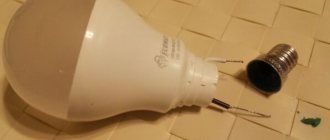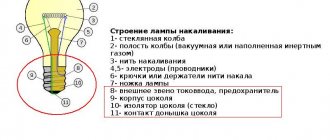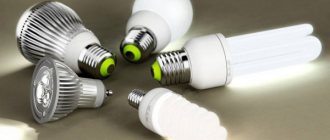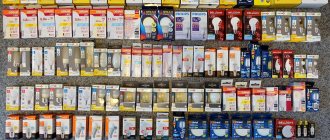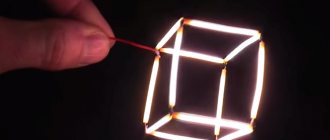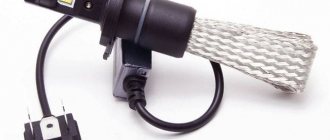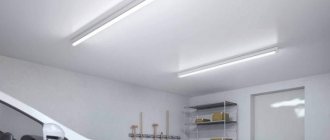Device and materials used
To understand the design of the plinths, you first need to find out what functions this part performs and what characteristics it must meet:
- The base acts as a conductor of electricity from the socket to the light bulb.
- Used to fix an element.
- Must be able to withstand operating temperature.
Overheating is dangerous for light bulbs.
The terminals of incandescent lamps are usually fixed with soft solders, the melting point of which is 180 degrees. Accordingly, the conclusions should not heat up to high levels. To compensate for thermal expansion, the cartridges have spring contacts.
Metals and plastics are used in the production of different types of bases. Metal elements are necessary for connecting and transmitting current.
Metal is a good conductor.
What are the differences between gu10 LED lamps and halogen lamps?
"Halogen" gu10
LED light sources are gradually replacing halogen ones. This comes with some very significant advantages.
Firstly, saving energy. To create an equal luminous flux, an LED light source needs up to 8 times less power. Of course, LEDs themselves cost more, but with long-term use, after 1-2 years, electricity bills will decrease noticeably. (The calculation applies to the lighting of rooms with the lights always on).
Secondly, LEDs heat up very little (up to 50-60⁰С; halogen ones - over 250⁰С)
This is important for spotlights and lighting built into suspended ceilings, for example, in kitchen cabinets
Thirdly, led gu10 is made moisture-resistant and shock-resistant. However, an LED lamp can work even with a damaged bulb.
Fourthly, if dimming is necessary, then LED lamps are the best option. Halogen light sources maintain their performance at maximum voltage. When it decreases, they turn into ordinary incandescent lamps. Therefore, dimming them is technically possible, but physically does not make sense. Dimmable LED bulbs cost more than conventional bulbs, but actually change their brightness as they operate, reducing energy costs.
When replacing halogen lamps with LED lamps in a particular lamp, pay attention to the overall dimensions: often light sources of different types with a similar luminous flux differ in size. In addition to size, these types differ in the direction of the light flux: the angle of incidence of light for halogens is wider than for LEDs
Therefore, when replacing some light bulbs with others, it is worth taking this parameter into account so that the overall illumination does not decrease. But for narrowly focused illumination, LED bulbs are the optimal solution
In addition to their sizes, these types differ in the direction of the light flux: the angle of incidence of light in halogen lamps is wider than in LED lamps. Therefore, when replacing some light bulbs with others, it is worth taking this parameter into account so that the overall illumination does not decrease. But for narrowly focused illumination, LED bulbs are the optimal solution.
How I chose GU10 LED lamps, review
GU10 LED lamps emit a narrow beam of light and are designed for spot lighting. They were created as a more advanced analogue of gu5.3 light bulbs, but unlike them, GU10 LED lamps have expanded contact elements of the base, thanks to which they are securely fixed in the socket using a rotary connection method.
The content of the article:
- Design features of gu10 LED lamps
- Technical characteristics of LED lamps GU10
- Why GU10 LED Bulbs Are Superior to Halogen Bulbs
- Price for LED lamps GU10
- Reviews of GU10 LED lamps
- Video about GU10 LED lamps
Design features of gu10 LED lamps
LED lamps gu10 mr16 have a specific design - extensions on the contacts of the base, due to which the lamp is firmly fixed in the socket with a rotary connection.
Unlike halogen lamps, gu10 mr16 have a number of advantages - long service life and powerful luminous flux with minimal energy consumption.
GU10 LED lamps do not heat up during operation, which is a big advantage and allows them to be used to illuminate objects that can deteriorate under the influence of the heat of a conventional lamp: food products on store shelves, synthetic clothing and car accessories, suspended ceilings and plastic-lined ceilings, etc. .P.
Scheme of led lamp gu10 mr16
The figure above shows the gu10 mr16 led lamp in a disassembled state. It consists of six components:
- Diffuser mount;
- Diffuser;
- Aluminium case;
- LEDs;
- Board with microcircuit;
- Base GU10.
The aluminum body of the lamp acts as a radiator and is capable of providing high-quality heat dissipation even at high light intensity.
Although LEDs do not get very hot, even a relatively low temperature of 60 degrees Celsius can destroy them. Therefore, a good radiator in LED light bulbs is extremely important. It can be made of aluminum or ceramic.
A reflector is built into the body of the gu10 mr16 LED lamp, which provides a concentrated direction of the light flux.
What does the name of the GU10 lamp mean?
GU10 is a base type. The Latin letter “G” means that a pin-type holder is built into the lamp body. The letter “U” indicates additional design features of the lighting device. The number “10” means the distance between the contact elements of the base, which is measured in millimeters.
Principle of operation
The operation of GU10 MR16 LED lamps is based on the pn junction principle, which ensures the operation of all semiconductor devices. The essence of this principle is the combination of positively and negatively charged particles, which results in the release of light flux.
Thickening of contacts in GU10 lamps for rotating connection of the base with the socket
Since gu10 LED lamps have a specific MR16 bulb shape, they are not installed in all illuminators in a row. They are usually used in spotlights and spots - concentratedly directed lighting devices for designer or decorative lighting.
Technical characteristics of LED lamps GU10
| No. | Parameter name | Short description |
| 1. | Supply voltage | Most models are powered from a 220 V network, but you can try to find devices that can operate in a wide range - from 85 V to 265 V. There are also models that operate from low-voltage automotive networks - 12 V and 24 V |
| 2. | Power | The most common models are with a power of 1.8-8W, but there are also more powerful devices that can consume up to 15 W of energy |
| 3. | Luminous angle | 24-180 degrees. The luminescence angle is quite narrow, which is explained by the specific shape of the bulb |
| 4. | Colorful temperature | Within 2,700-8,000 K |
| 5. | Average luminous flux | 300-700 lm |
| 6. | Number of LEDs | From a few pieces to several dozen |
| 7. | Color rendering index | From 75 (cool light) to 85 (warm light) |
| 8. | Life time | On average, a GU10 LED lamp can operate continuously for up to 50 thousand hours |
Why GU10 LED Bulbs Are Superior to Halogen Bulbs
GU10 LED lamps were created to replace halogen lamps in order to overcome some of their disadvantages. GU10 LED lamps have a directional luminous flux and are used to replace halogen lamps in accent lighting, spotlights, recessed fixtures, table lamps and many types of decorative lighting.
By choosing GU10 LED lamps instead of halogen lamps, you can take advantage of their significant advantage, which primarily lies in energy saving.
LED bulbs use much less energy than most other types of bulbs, including their halogen counterparts.
The second advantage is that LED bulbs do not produce heat, making them safe to use anywhere additional lighting is needed, even inside closed cabinets. GU10 LED bulbs are moisture resistant and impact resistant because they are coated with resin. This allows them to be used almost anywhere where light is needed.
Price for LED lamps GU10
| Model name | Specifications | Price in rubles |
| Telefunken (TLF) 9W | Power – 9 W, light output – 540 Lm, voltage – 220-240 V, lighting angle – 120 degrees, service life – about 10 years, glow color – warm white, equal in brightness to a halogen lamp – 75 W | 190,00 |
| Leduro 8W | Power – 8 W, luminous efficiency – 600 Lm, voltage – 220-240 V, lighting angle – 60 degrees, service life – about 8 years, glow color – yellow, equal in brightness to a halogen lamp – 75 W | 890,00 |
| Gauss 7W | Power – 7 W, luminous efficiency – 500 Lm, voltage – 100-240 V, lighting angle – 100 degrees, service life – about 10 years, glow color – warm white, yellow, equal in brightness to a halogen lamp – 75 W | 530,00 |
| X-Flash 5W | Power – 5 W, light output – 260/290 lm, voltage – 220-240 V, lighting angle – 90 degrees, service life – about 10 years, glow color – warm white, yellow, equal in brightness to a halogen lamp – 50 W | 350,00 |
| LeoLed 5W | Power – 5 W, light output – 300 lm, voltage – 85-240 V, lighting angle – 120 degrees, service life – about 10 years, glow color – cool white, warm white, yellow, the brightness corresponds to a halogen lamp – 50 W | 250,00 |
| Gauss 4W | Power – 4 W, light output – 250/270 lm, voltage – 100-240 V, lighting angle – 90 degrees, service life – about 10 years, glow color – warm white, yellow, equal in brightness to a halogen lamp – 35 W | 280,00 |
| Telefunken (TLF) 3W classic | Power – 4 W, light output – 150/170 lm, voltage – 220-240 V, lighting angle – 60 degrees, service life – about 10 years, glow color – warm white, yellow, equal in brightness to a halogen lamp – 25 W | 100,00 |
| Gauss 2.5W | Power – 2.5 W, light output – 160/180 lm, voltage – 100-240 V, lighting angle – 120 degrees, service life – about 5 years, glow color – warm white, yellow, equal in brightness to a halogen lamp – 25 W | 175,00 |
Reviews of GU10 LED lamps
Two months ago I installed 7W Gauss gu10 LED lamps in my kitchen, directly above the work area. I paid 2,650 rubles for five light bulbs. The total power of their luminous flux is 2500 Lm. This brightness is more than enough to easily cook food, while electricity bills have become an order of magnitude lower over the past two months. Since my kitchen is small - 9.5 square meters. m., the light from gu10 bulbs is quite enough to illuminate it completely, without turning on the ceiling chandelier.
Reviews I found online about the gu10 LED bulbs indicate that people are generally happy with these bulbs. LED lamps from Navigator, Gauss, Osram and others are especially popular. The only disadvantage of gu10 LED lamps, according to most Internet users, is their high price.
Video about GU10 LED lamps
- How to choose the right lighting for your home
- A concrete kitchen countertop and a stone sink are the main...
- Natural and artificial lighting of premises
- Modern lighting in the interior
- Advertising on the website
- Hanging lamp
Types of lamps with r7s base
Having visited an electrical equipment store and examined the assortment, you will find two types of R7S lamps - hidden in a glass bulb and open-type products without a protective shell. It is best to purchase devices of the first type, since glass provides additional protection against moisture and dust.
One of the models in the R7S series is lamp 118 (which indicates the length of the product - 118 mm). This is the most common device used in lamps of medium and large dimensions. More compact light sources, including portable lanterns, use 78 mm lamps, the shape of which exactly follows the barrel.
The main difference between different models of R7S lamps is related to power. The upper limit is small and is usually 6, and the average value is 4 W. There are several rules and recommendations for choosing R7S LED products.
Types of lamps with gu10 base
Halogen
The device is similar to incandescent lamps. The main difference is in the composition of the buffer mixture that fills the glass flask: bromine and iodine vapors are added to the “halogens”. Due to halogen vapor, service life (up to 4000 hours) and light output (17-22 lm/W) are increased. They shine with a warm, even yellow light. They are inexpensive. However, they consume a lot of electricity, depend on mains voltage fluctuations and get very hot during operation (over 250⁰C). In addition, they should not be touched with bare hands to avoid premature breakdowns.
LED
LED lamps are characterized by maximum light output (80-120 lm/W) and service life (up to 50,000 hours). They consume a minimal amount of electricity. The color temperature is in the range of 2800-6500 K, which allows you to choose the light that is most pleasing to the eye. Some models are compatible with dimmers. Scattering angle from 12 to 36⁰. With a special diffuser, it increases to 60⁰.
Important parameters that affect the quality of the luminous flux are the pulsation coefficient and the color rendering index. It is better to choose light sources with a pulsation coefficient from 5 to 30% (the lower the better) and a color rendering index above 80. With such indicators, your eyes will not get tired, and colors will not be distorted.
Disadvantages include high price, dependence of operation on the stability of the network voltage and physical degradation of LEDs, which leads to a decrease in brightness during operation.
As an example, consider a gu10 LED with a luminous flux of 400 lm. Let's take a mid-price lamp: NAVIGATOR 5W GU10 400lm 4000K 230V spot PAR5. Such a light source costs an average of 90 rubles.
NAVIGATOR 5W GU10 400lm 4000K 230V spot PAR5
Power is 5 W. Color temperature is 4000 K, which corresponds to neutral white light. The lamp is made in the form of a spot, the bulb is matte. The diameter is 50 mm, length is 57 mm. A good color rendering index is 89. There is no dimming function. Rated service life is 35,000 hours. Power equivalent to a 35-watt incandescent lamp.
Features of the species
Separately, it is worth paying attention to the fact that gu 10 light bulbs are intended exclusively for use in the interior of buildings. As a rule, these light bulbs are divided into two types of available bulbs - these are cone and cylinder shapes
Cone lamps are more in demand
It is important to note that both presented types have absolutely identical methods of delivering light fluxes. All rays of light are combined into a beam of a certain direction
As for the design features, the elements are of open and closed types. They differ from each other in the location of the light diodes around the perimeter of the structure. The open system emits a richer light, while the closed type of the bulb allows light to pass through using a diffuser made of matte material.
Plinth markings
For quick identification, a code consisting of Latin letters and numbers is used. The information is on the packaging. Some manufacturers indicate the basic geometric dimensions of fasteners. The capital letter in the code indicates the size, the number indicates the diameter of the retainer (either the cross-section of the bulb or the distance between the internal parts of the contacts), and an additional small letter determines the number of rods. Sometimes an additional 2- or 3-digit number is added to the designation, indicating the length of the light bulb.
In Russia, GOST 25834-83 is in force, regulating labeling. Separate requirements for the application of information are formed by standard 18620-86. Domestic regulations require the indication of the date of manufacture, the manufacturer’s trademark logo and the symbol of the light bulb. For a number of products, the standard requires the listing of data that ensures the safety of use. Separate regulations GOST 17100-79 and 28108-89 apply to fasteners.
Basic letter
Capital letters in the marking indicate:
- B – standard size with pin mounting;
- BA – pin-type socket for automobile light bulbs (the differences are different pin lengths and requirements for the minimum current leakage path);
- BM – special explosion-proof version for use in mines;
- E - standard version with screw thread, developed by T. Edison;
- F – mount with a single contact rod and a light bulb body used as a second contact;
- G – design with contact plates (the group includes the Bi-Post standard size not used in the 21st century);
- K – cable (or elastic) connection option;
- P – standard size with focusing element;
- R – circuit with plates hidden inside the housing;
- S – cylindrical soffit type retainer without pin;
- SV – S version, equipped with conical tips;
- T – telephone format;
- W – baseless circuit (interface with the cartridge is carried out through a glass bulb).
The marking of the caps consists of letters of the Latin alphabet and numbers.
Occasionally, an additional letter is introduced into the labeling, which allows one to determine the purpose or design features of the product. For example, products for cars are designated by the letter A.
Number
The number used in the marking allows you to clarify the design features:
- case diameter – for products of formats B, VA, VM and K;
- outer diameter of the thread - for units with a threaded Edison glass;
- contact pin characteristics – for F format products;
- position of the rods (for example, the distance or diameter of the circle on which the elements are installed) - for standard G products;
- diameter of the section providing lateral centering - for products of type P;
- cross-section of the insulator, including the interface with the socket, for light bulbs of standard sizes R and S;
- external distance between contact plates - for T standard products;
- thickness and width of the mounting glass blade (values are separated by x) - for W format automotive indicators.
Lower case
The designation contains the following lowercase letters:
- a – indicates the standard round section of the contact pin;
- b – used for marking rods with a corrugated outer surface (rare);
- c – used for marking contacts with a special profile;
- s – indicates the presence of a single rod for power supply;
- d – used to designate nodes with 2 contacts.
There are lamps with LED plates.
There are products with additional spirals or LED plates that require power supply again. When using 3, 4 or 5 contacts, the letters t, q and p are entered into the encoding, respectively. To highlight the number of positional planes from the code, use the dash sign.
Why are halogens leaving the market?
The appearance of LED lamps on the market has virtually eliminated sales of halogen lamps. This is understandable, because LED lighting devices have a huge number of advantages (we won’t talk about them here). And yet the halogen lamp with a GU 10 base is still used today.
Manufacturers offer several models that differ from each other in power ratings. It varies from 10 to 75 watts. The lamps themselves are powered from a 220 volt network.
But here the matter is different. Any lamps with a GU 10 base have, so to speak, a directional light beam, so their main use is to organize illumination of a small area. That is why lamps with such lamps are most often used not for general lighting, but purely for design needs. Or in other words, for accent lighting. Therefore, most often such lamps are installed in “spot” type lamps.
But the use of such light sources is a huge area. They are mainly used to illuminate shop windows, paintings in art galleries, and above reading tables in libraries. In everyday life, they are installed in kitchens to illuminate the work area, in bathrooms, and in hallways near the mirror.
It should be noted that the technical characteristics of GU 10 halogen lamps, especially dimensional indicators, may differ from one manufacturer to another. But the main ones are almost the same. For example, 35 W models.
- The luminous flux is 650 CD.
- Dispersion angle 35º.
- Service life up to 2000 hours.
- Most often these are mirror type lamps with an aluminum reflector.
Are there 12 (24) volt GU10 bulbs?
They are not mass-produced by anyone. As we have already said, the GU10 base was originally intended for direct connection to the network, i.e. for 220 (110) volts. Therefore, such a question is almost always caused by an elementary mistake, when one person does the design (and installs a 12-volt transformer in the circuit), and another person does the purchasing of lamps (and purchases lamps for the GU10 base).
If this is not the case, and you really need LED lamps with a GU10 base for a different voltage (12, 24, 36, 80 volts, etc.), contact us - we can make such lamps for your specific order. The supply voltage for the lamps can be whatever you need, as well as the type of current (AC and/or DC). But the number of lamps in such an order should be from 1000 pieces.
Often in a store the question “What base do you need a lamp with?” you can hear the following answers: “Well... with an ordinary one..”, “Well... with a big one...”, “... with flat ears...” or “... there are two needles sticking out there...”?
How correctly the client guesses the type of base will depend on his return visit to the store.
What kind of lighting do you prefer?
Built-in Chandelier
There are only 11 common types of lamp bases. Here they are: E27, E14, GU4, GU5.3, GU10, G4, G6.35, G9, GX53, GX70, E40.
The easiest way to remember them is to leave the lamp packaging after purchase or cut out the side of the box that has the base designation on it. On the other side, you can sign with a pen in which rooms such lamps are installed.
A more difficult method is to remember names and numbers. Let's consider it.
E27 and E14 sockets are the most common in everyday life and are often found in table lamps, chandeliers, sconces, and floor lamps. They have a characteristic carving. The numbers after the letter “E” indicate the diameter in mm: 27mm and 14mm. The thickness of the E14 base is associated with the diameter of the AA battery. Socket E27 is easily recognized by store sellers by the name “Ilyich light bulb”.
GU4, GU5.3 – bases in the form of metal pins-needles, the distance between which is 4 and 5.3 mm, respectively. Basically, lamps are produced in the form of a hemisphere in glass, plastic, ceramic or metal cases. The area of the pins is rectangular.
There are also lamps in the form of elongated cylinders ( bases G4, G6.35) , made of transparent silicone or plastic.
The GU10 socket consists of two pins similar to “T-shaped” cylinders, which, when turning the lamp, fix it in the lamp socket. The center distance of the pins is 10mm.
The G9 base looks like two bent wires, forming two ears. Another version of it is two metal plates with holes. Typically, lamps with such a base are made in plastic housings with a bulb or open-framed - filled with transparent silicone.
Lamps with GX53 and GX70 sockets have “tablet” shapes and look good in interiors with suspended ceilings. The pins are similar to the GU10 base with the only difference being the distance between them: 53mm and 70mm.
And finally, E40. You will not find this base in your home. He is a frequent guest in street and industrial lamps. The base looks the same as that of the “Ilyich light bulb” and has a diameter of 40 mm.
How to determine the base type of an LED lamp?
The review includes the BBK M53F model in the MR16 housing for 220V; there are also models for 12V; they differ only in the driver. LED spotlights have small dimensions, so when replacing halogen with LED, it is important to take this into account.
Expert opinion
It-Technology, Electrical power and electronics specialist
Ask questions to the “Specialist for modernization of energy generation systems”
How to change an LED light bulb in a spotlight In today's world, people prefer to use LED lamps instead of traditional incandescent lamps, as they are economical and durable light sources. Ask, I'm in touch!
Compatible with other sizes
The connection of the base allows, if necessary, to replace the part or carry out repair work. This option is not directly compatible with others, but the problem can be solved by using special adapters.
Application of base adapters
When you need to insert a lamp into a socket that is not intended for it, you can use special adapters. They simply allow you to go, for example, from size E14 to E27 without losing power or any other qualities.
But there is also a drawback - the length of the structure, which is not always convenient. If the light bulb protrudes strongly from the shade, this negatively affects the appearance of the lamp, and also increases the risk that the light bulb can be accidentally touched and broken. Therefore, the use of adapters is not always advisable.
Base adapter from 14 to 27 mm.
As for the range of adapters, there will be no problems. They are presented in an assortment in lighting stores, and the required adapter can also be ordered online. Adapters are produced by Cosmos, OBI, Lemanso, E.Next and dozens of others. There are even models for combining different types of bases, for example from G9 to E27 or vice versa. Dual type models are available; two lamp sockets can be output from one input. The cost starts from ten rubles and can reach several hundred.
“Geographical features” of the bases of ordinary household lamps
Edison threaded lamps are available on the domestic market in three standard sizes - E27, E14 and E40 for industrial and street lighting. Similar light bulbs are used in Europe. This allows you to purchase chandeliers, sconces, and lamps from European manufacturers practically without any problems.
The exception is Britain, where the plinths are not threaded and are equipped with a snap-on bayonet mount. There are also differences between household light bulbs used in Canada and the United States of America. In these countries, threaded sockets E12, E17 and E26 are common. In addition, instead of the powerful large E40, they use a different E39 base from the standard one. It should be borne in mind that this difference is due not only to the size of the base, but also to the voltage. Bulbs with E26 and E17 sockets operate from an electrical network with a voltage of 110V.
Design features, principle of operation
LED light sources with a GU10 base are designed in a similar way as other analogues based on semiconductor crystals, created for connection to a 220V network: a current stabilizer built into the design; holder; a certain number of point light sources. The main feature of this type of lamp is the specific shape of the bulb - MR16 (reflector).
Lighting elements with a GU10 base are designed for connection to a 110-220V network; accordingly, only a few existing manufacturers are engaged in mass production of low-voltage light bulbs in this design. However, if necessary, it is possible to make an individual order.
Lamp device:
- Diffuser mount
- Scattering element
- Frame .
- Board with LEDs
- Electronic board
- Base
The light sources under consideration also provide a radiator with a large coverage area, which ensures normal operation of the lamp even at significant power. A lighting element with a GU10 socket is usually equipped with a reflector that helps produce directional light.
The holder itself is pin (G), the distance between the contact elements is 10 mm, as indicated by the lamp designation. The additional letter U indicates additional design features of the light source.
Lamps with a GU10 base have thickenings at the end of the contacts for rotating connection with the socket
The basis of operation is the principle of the pn junction, which allows positively and negatively charged elementary particles to connect, and under the influence of current they move towards the pn junction. The result of these processes is the release of visible light energy.
If you need to get a direct directional glow, then special lamps and LED lamps equipped with a GU10 base are best suited. These are the light sources that are usually used in spot lighting devices. Therefore, the main area of application is design, interior lighting.
Characteristics
Spectrum LED lamps with GU10 base are in the middle price range. Retail price: 6 W - 78 rubles, 10 W - 164 rubles, due to the start of sales, the price was reduced by 30% to 60 and 126 rubles.
| Parameter | 6W GU10 | 10W GU10 |
| Light flow | 450lm | 780lm |
| Nutrition | 220-230V | 220-230V |
| Colorful temperature | 3000K | 3000K |
| Luminous angle | 120° | 105° |
| Color rendering index CRI | >80 | >80 |
| Life time | 17,000 hours | |
| Ambient temperature | -20° to +40° | |
| Price | 60rub | 126rub |
| Guarantee | 24 months |
The service life can be indirectly judged by the warranty period; for bad light bulbs it will be 1 year. The Polish brand Spectrum LED provides a 2-year warranty period for its lamps, during which you can exchange for a new one.
These bulbs can be screwed into a standard E27 socket using an adapter.
Base GU5.3
GU5.3 is a modification of the GU10 pin socket, designed for low voltage networks - 12V. The 12V voltage is obtained from a 220V network by connecting a step-down transformer to the circuit. The GU5.3 pin spacing is only 5.3mm, so the pins don't have the bulges found on the GU10. Consequently, the method of fixing them in the cartridge may differ.
Various modifications of LED light bulbs with a GU5.3 base can operate both from a 12V network and from a voltage of 220V, excluding the transformer from the circuit. Such LED lamps consume 3-6 W.
The scope of application of lamps with a GU5.3 base is illumination of shop windows, art galleries, suspended or suspended ceilings, as well as furniture and other interior objects.
Where can I buy?
You can purchase Spectrum LED lamps with a GU10 base in Yandex Market and in the online store of the official distributor TSC Teplomarket LLC, which provided samples.
Link to GU10 6W and GU10 10W.
Author: Sergey Kazantsev
Samples were tested in a lighting laboratory, official website led-obzor.ru.
I have been working since 2015. I test LED lamps for the home, LED strips, lamps, spotlights. I test automotive LED lamps, halogen and xenon, fog lights, daytime running lights, LED lenses according to GOST. I use low-beam headlights, xenon and halogen lenses, and fog lights.
Addressing the audience. Before you start getting indignant and asking questions, try to read the material carefully. Half of the questions arise because they were not read carefully.
Options to select
The ability to connect to a 220V power source is usually provided in most of these light bulbs. If you plan to replace halogen lamps with the same base (GU10), you need to carefully select an analogue in terms of power.
Experts recommend purchasing LED lighting elements at the rate of: 3W of power per square meter. m area. Accordingly, when choosing, you need to determine where the light source will be installed.
Classic interiors require warm yellow light, similar to the light from an incandescent lamp, while modern hi-tech design often uses cold light
If you plan to replace old halogen lights, again, the emphasis is on power: the value of this parameter should be divided by 6-7. The result will be a sufficient value of the required load capacity of the lamp.
It is also important to check how freely the light source will fit in the suspended ceiling structure or in another selected area
Value for money
Some manufacturers were considered: Kreonix, X-Flash, Lexman. The price of such lamps is in the range of 200-300 rubles. With similar parameters (6 W, 300 lm), almost all specimens perform well during testing, with a few exceptions: Lexman is characterized by increased pulsation. However, the more powerful analogue (7 W, 500 lm) is characterized by ideal operation, the pulsation coefficient is 1%.
There are other, more well-known analogues, for example, Navigator, Gauss. These brands are known for their reliable products. Moreover, 220V LED light sources in these variations are in the same price category. And the declared parameters remain unchanged during operation. This suggests that when choosing, it is better to give preference to trusted manufacturers.
The electronic “filling” of the GU10 220V lamp also plays a role. Significant flaws in the mechanism lead to excessive heating of the case and too rapid burnout of the diodes. Accordingly, the service life of such products will be minimal, sometimes even shorter than that of halogen lamps.
If you consider that the price of diode analogues is much higher, you won’t be able to save money, because you will have to regularly replace the GU10 220V light source. This means that it is better to immediately purchase a reliable product from a trusted manufacturer.
Products from Gauss
These advantages allow you to use a light source with such a 220V base when arranging furniture or ceiling interior lighting. When choosing, you need to try to correlate the parameters of the lamp and the subtleties of its future operation. This approach will ensure the implementation of the most effective solution based on the use of the light bulbs in question. Before purchasing, you should pay more attention to the power and dimensions of the product.
Energy consumption
We measure power using a wattmeter and an adapter from the GU10 to E27 base. Real energy consumption turned out to be lower than stated by 9% for 6 W and 5% for 10 W, which means we will pay less for electricity than expected.
| — | 6W GU10 | 10W GU10 |
| Energy consumption | 5.44W | 8.52W |
How to choose
Before purchasing a gu 10 light bulb, you should pay close attention to the technical characteristics. In order to have an idea of how bright the light will be, as well as how natural the colors of the objects in the room will remain, it is worth studying the following:
- how light rays arrive;
- to what temperature the light heats up, which means what color it will shine;
- color rendering level.
It is these features that are responsible for how high quality the lighting will be.
As mentioned above, LED light bulbs require a power supply of 220 Volts. If the lamp was originally equipped with a halogen lamp marked gu 10, then certain requirements will be imposed on a lamp with diodes of a similar base. For example, the voltage power should be set to the one that was used previously.
Advantages and disadvantages
When choosing a lighting scheme for their home, people often decide to use a standard E27 type socket. And this is not strange, because it has many advantages:
- Popularity. The main “competitor” for E27 today is E14, both sizes are available in almost every store. There is no need to order a rare type of light bulb online.
- Price. The mass nature of the product and inexpensive components make it accessible to everyone. Products with E27 socket are inexpensive.
- Range.
Incandescent, LED, halogen and energy-saving models are sold with this base. Also, every manufacturer has E27, so you can choose a lighting device based on quality and cost. The E27 size is available in most popular lamps. - Does not deform. The Edison base, including size 27, is a very durable structure, the shape of which is not affected by temperature changes or shaking during transportation.
- Power. With such a base there are devices even rated at 300-350 W, which is enough even for a relatively small production.
Flaws:
- Possibility of corrosion.
If the base starts to rust in the lamp, it will not be easy to remove it later. A rusty base can cause a lot of problems - There are low quality products. The range of lamps of this size is really large, there are even very low quality models from little-known manufacturers.
Labeling of LED lamps: explanation of the symbols on the packaging
To prevent the PVC film around the body from melting and turning yellow, it is necessary to comply with the maximum power requirements, this is 5-7 W for LED lamps Source piramida-stroi.ru
If the cartridge will be built into a plasterboard ceiling, then you need to fix the spring fastening only after painting the gypsum board Source youtube.com
Installation of lamps without a mortgage can be carried out with certain modifications to the product - this is done when the socket is attached directly to the concrete floor Source piramida-stroi.ru
| Lumens (Lm) | Power consumption of the lighting device, W | ||||
| Incandescent lamp | Halogen lamp | Fluorescent Lamp | Light-emitting diode (LED) lamp | ||
| 250 | 25 | 18 | 6 | 4 | |
| 450 | 40 | 28 | 9 | 6 | |
| 800 | 80 | 42 | 13 | 9 | |
| 1100 | 75 | 53 | 16 | 12 | |
| 1600 | 100 | 72 | 20 | 15 | |
Expert opinion
It-Technology, Electrical power and electronics specialist
Ask questions to the “Specialist for modernization of energy generation systems”
LED lamps GU10 220V - buy in the online LED lighting store LEDPremium in Moscow 3 but such an LED bulb does not fit into the lamp itself, I bought G4 halogens yet, I don’t know how to choose LED ones, please help. Ask, I'm in touch!
Design features of the gu10 base
Appearance and overall dimensions
It is noticeable from the drawing that there are thickenings at the ends of the contacts of the base. These are the main design differences between the gu10 and other pin models.
The main purpose of the thickenings is strong fixation in the lamp socket. In addition, lamps with gu10 are simply and quickly inserted into the socket: just insert the light source and turn it slightly. The contact will not be lost during operation.
Additionally, such a base ensures electrical safety: gu10 are used only in networks with a voltage of 220 V. They cannot be inserted into the socket of low-voltage lamps.
The marking of the caps is quite simple: the letters indicate the pin type with rotary locking, and the numbers indicate the distance between the centers of the pins. In this case the distance is 10 mm.
Advantages
The main place for using LED lamps with a GU10 base is suspended or false ceilings. And since these lamps heat up little compared to the corresponding halogen lamps, the appearance of the ceiling is preserved.
What is a GU10 base?
- This is a bayonet two-pin lamp base with a distance between pins of 10 mm. To fix the light bulb, you need to insert it into the socket and turn it. Another, no less common name for this plinth is “the kind with thick legs with knobs.”
The GU10 socket was originally intended for direct lamps, i.e. for power supply 110-220 volts.
How to choose?
As with all halogen lamps, when selecting an LED replacement, we recommend dividing the power by 6-7. Many sellers advise dividing the halogen power by 10, but you shouldn’t believe this - it will become darker. Halogen lamps have a relatively high efficiency, so when choosing an LED lamp with a GU10 base, we recommend a factor of 6-7.
Also pay attention to the height of the lamp - it grows with power, and the lamp must accommodate the entire lamp!
LED lamps with GU10 base – TAUREY
We deliver throughout Russia and the CIS by mail and transport companies. In all major cities of Russia and the Moscow region, courier delivery to your door is possible.
Expert opinion
It-Technology, Electrical power and electronics specialist
Ask questions to the “Specialist for modernization of energy generation systems”
Review of LED lamp GU 5.3 for 12V and 220V MR16 The GU10 base consists of two pins similar to T-shaped cylinders, which, when the lamp is turned, fix it in the lamp socket. Ask, I'm in touch!
Marking
The domestic designation of energy-saving light bulbs contains a letter indicating the type:
- L – luminescent;
- B – white light;
- TB – white with a warm tint;
- D – daytime color;
- C – improved color rendering;
- E – improved environmental performance;
International designation is a digital designation, where the first digit shows the color rendering index, and the rest indicate the color temperature in hundreds of degrees Kelvin.
Table of characteristics of various types of light sources:
Based on the type of base, energy-saving sources are divided into:
Plinth designation:
- 2D – curved configuration, in the shape of a square. The base has the shape of a rectangle 60 x 36 mm. Power – 16, 28, 36 W.
- G23 – has the shape of a tube folded in half. Power 5 – 14 W.
- 2G7 - similar to G23, this type works with ballasts. The base has 4 contacts.
- G24 – the shape is similar to G23, it has the shape of a quadruple folded tube. Output power 10 – 36 W.
- G53 – disc-shaped, 16-20 mm thick and 73 mm in diameter. The device has a curved shape. The power of this type is about 6 -11 W.
- E14, E27, E40 - have a screw-in Edison type base. The digital designation indicates the diameter of the base.
Types of lamps with E27 base, their features
Lamps differ in operating principle and performance characteristics. Each type is also presented under the E27 label.
Incandescent lamps
The device of a standard incandescent light bulb.
The oldest version of lighting lamps, it was for them that the E27 base was developed, so this size is most often installed in incandescent lamps. As for the technical characteristics, the power ranges from 15 to 250 W, and the luminous flux is about 10 Lm/W.
Advantages:
- low price;
- even light;
- not afraid of moisture;
- simple design.
Minuses:
- high energy consumption;
- short service life;
- fragility of the flask;
- heat.
Read more about the characteristics and types of incandescent lamps here.
Halogen
Halogen lamp device.
The operating principle is similar to incandescent lamps, but additionally halogen vapors enter the bulb. This increases the luminous flux, which reaches 17-20 Lm/W. For halogen models, a base marked G is more often used.
Advantages:
- work at different temperatures;
- not afraid of moisture;
- good and uniform light;
- price.
Flaws:
- requirements for stable voltage;
- high power consumption;
- You can only touch them with gloves.
Pin option
When choosing, you need to focus on the distance between the contacts (pins). If the number of protruding elements is more than 2, the diameter of the holder circle becomes a guide. Depending on which versions of the lamp with pin holder are selected, it becomes possible to connect the lighting system to a power source of 220 volts or 12/24 volts.
The G4 holder can be found in halogen lighting elements designed to be connected to a 12/24 volt power source. Purpose – spot light, built-in lighting systems. Low-voltage lamps with such a holder can also be LED. The G5 version is used in luminescent analogues, for example T5.
The GU5.3 holder is part of lamps whose intended purpose is built-in lighting systems. This option is included in the design of LED and halogen lamps; it is suitable for a light source of the MR16 type, which, in turn, is used to organize the illumination of display cases, niches and decorative lighting. The power source can be a 12/24 volt or 220 volt power supply.
A special feature of GU10 is flattening at the end sections of the contact elements, which contributes to a more reliable connection with the cartridge. Light sources with such a contact part are powered by a 220 volt network.
Analogue GU6.35 - similar in characteristics to the GU5.3 version, but the distance between the pins is 6.5 mm, and only a 220 volt AC network can act as a power source. While the G5 type is characterized by contact elements in the form of pins, the G9 version is equipped with elongated hinges. The distance between them is 9 mm. These types of lighting sources are used when organizing accent lighting and decorative lighting.
Design G13 is a common option, used in LED and energy-saving fluorescent light sources with a cylindrical bulb shape. Thanks to this feature, the named types are interchangeable.
Option G23
The distance between the pins is 13 mm. Another version of G23 is slightly different in configuration, since in addition to the pins, the holder also has a plastic protrusion. Fastening is carried out by installing contact elements in a socket with holes.
Compact fluorescent lamp sockets
An analogue of the G53 holder is characterized by a significant distance between the pins - 53 mm. The intended purpose of lamps with such a contact element is directional light in shopping areas, restaurants, galleries. The GX53 version is used in light bulbs for installation in suspended and suspended ceiling structures. The pins are shaped similar to the GU10 pins. When installed, the light turns.
Selecting a lamp based on the base type
First of all, it is necessary to determine which network the connection will be made to: 12/24 V, 220 V, because different types of holders can be designed for connection to networks with different parameters. The choice of contact element for halogen, LED and energy-saving lamps is made based on the design of the lamp in which it is installed.
Each option is designed for use in certain conditions. There are versions for permanent and variable networks. In addition, you can choose a light bulb holder for a lighting fixture for different purposes: recessed or pendant lamps, directional or diffuse lighting options, functional or decorative lamps.
Types and sizes of lamp bases
The socket is an element necessary for fixing the lamp in the socket and supplying electric current to it. Modern lamps use different types of sockets.
There are many types of bases. Therefore, before you run to the store for a new lamp for a lamp or sconce, it is important to pay attention to the base of the lamp used in the lamp.
Tip: modern Chinese chandeliers and lamps often use lamps with very exotic bases. To avoid the problem of finding replacement lamps in the future, buy electrical products designed for lamps with popular sockets.
The plinth designation system consists of several elements:
I) The first letter indicates the type of base :
- “E” indicates that this threaded base (Edison base) is one of the most popular (E27, E14);
- “G” in the name of the base indicates that this pin base is the second most popular (G4, GX53);
- “R” means that this base has a recessed contact (R39, R63);
- "P" indicates the focusing base;
- “B” indicates that this base is a pin type (also known as a bayonet mount);
- “S” indicates that the base is soffit.
II) You will also find a number in the name of the base. This is the diameter of the connecting part of the base or the distance between the pins.
III) The name of the base may contain lowercase letters. They indicate the number of contact plates, flexible connections or pins in a given base.
- s = one contact,
- d = two contacts,
- t = three contacts,
- q = four contacts,
- p = five contacts.
Threaded base (E14, E27, E40)
Conventional lighting lamps have a threaded base with an outer diameter of 14, 27 or 40 mm and a special thread with a large pitch. Such bases are called E14, E27 and E40, respectively. The letter designation “E” (Edison) means a screw device. The number that comes after the letter in the classification corresponds to the outer diameter in millimeters.
Lamps with E27 (ES) socket are the same “Ilyich bulbs” that we are all accustomed to. They are most often used in chandeliers, shades, wall and table lamps. The E27 socket is a threaded system for quickly connecting the socket and lamp with a diameter of 27 millimeters. Such lamps are most often powered by 220V alternating current (AC).
Base E14 (SES) is also very popular. Lamps with such a base are often called “minions” for miniature classic lamps and sconces. In almost any apartment there is a place where lamps with such a base are installed. Most often this is a kitchen, toilet or bathroom, corridor. Lamps with an E14 base are often shaped like a candle (C37), ball (G45), or mushroom (R63, R50, R39). Such lamps are most often powered by 220V alternating current (AC). The diameter of such a base is 14 mm.
Lamps with E40 socket (GES) most often have high power and are used in industrial and street lighting. For example, DRL lamps have just such a base. Such lamps are powered by 220V alternating current (AC). The diameter of such a base is 40 mm.
In addition, the following less popular threaded bases are available:
- E5 - micro base (LES) with a diameter of 5 mm,
- E10 - miniature base (MES) with a diameter of 10 mm,
- E12 - miniature base (MES) with a diameter of 12 mm,
- E17 - small base (SES) with a diameter of 17 mm,
- E26 - medium base (ES) with a diameter of 26 mm.
Pin base (G4, GU5.3, G6.35, GU10, G9, G13, G23, G53, GX53)
Indicated by the letter G. A pin system is used to connect the lamp to the socket. The numbers in the designation show the distance between the centers of the pins (in the figure this distance is equal to N), and for a larger number of pins the diameter of the circle on which the centers of the pins are located.
For sockets of this type, additional designations are often used indicating non-interchangeable modifications of lamps: U, X, Y, Z. For example, lamps with GX 53 and G53 sockets have the same distance between the centers of the pins (53 mm), but require completely different connectors for connection .
The GU5.3 base is most often found in halogen and LED lamps of size MR16, which are used in niche lighting, household, decorative and display lighting. Typically, such lamps are powered from a 220V (AC) or 12V (AC/DC) network. By the way, this base is very popular among LED lamps.
a GU10 rotary also have a standard size of MR16, are inserted into the socket and turned until it stops in a special lock. Therefore, they are used where other lamps may fall out due to vibration or external influences. Lamps with a GU10 base are usually powered from a 220V alternating current (AC) network.
Externally, lamps with GU10 and GU5.3 sockets differ only in the thickness and appearance of the pins.
The G4 socket is designed for miniature lamps with MR11 housing, which are widely used for decorative lighting applications due to their bright spot light. These are mainly low-voltage lamps for 12/24V voltage, but they are also found at 220V (AC). The advantages of these lamps manifest themselves primarily in recessed ceiling luminaires and flexible lighting systems.
The G6.35 base is very similar to the previous ones. The distance between pins is 6.35 mm. These lamps are usually powered from a 220V(AC) alternating current network.
The G9 base is also a pin base, in the form of two elongated loops of wire with a distance between the pins of 9 mm. Lamps with a G9 socket are used in accent and decorative lighting fixtures, and recently they are often found in chandeliers for the home. The pin base is very easy to use - installing and replacing lamps is quick and easy.
The G13 base is a pin base with a pin spacing of 13 mm. Lamps with this base are most often installed in lamps such as Armstrong, LPO, LVO, LSP and others.
Tubular fluorescent and LED lamps T8 have the same base G13 and are analogues.
The G23 base is a base with a pin spacing of 23 mm. Lamps with this base are often used in table lamps, shower and bathroom fixtures. The base sockets of such lamps have special holes for installation in ordinary wall lamps.
The GX53 socket is often used for suspended and suspended ceilings in residential and office spaces due to the low height of lamps with this socket (28 mm). Such lamps also turn all the way with a special lock (like lamps with a GU10 base). The distance between the centers of the pins is 53 mm. Lamps with GX53 socket usually operate on 220V alternating current (AC) and do not require any transformers.
To connect such lamps, a lamp suitable for the base is usually sufficient; no additional sockets are required.
The GX70 base is the “big brother of the GX53 base.” It is absolutely similar to it, with the only difference being that the distance between the centers of the pins is 70 mm.
A lamp with a G53 socket is used in areas where directional lighting is required, for example, to create accent lighting for objects in shopping areas, restaurants, exclusive boutiques and galleries, in rooms with high ceilings, or to illuminate the stage.
A lamp with such a base is most often used in lamps with a hinged lamp mount of the “cardan” type.
Similar articles:
Color temperature of LED lamps and luminaires
How are the brightness and color temperature of light related in his perception?
Types of LED lamp bulbs
How to determine the required power of an LED lamp
Back
All articles
Energy-saving lamps
Energy-saving lamps are compact fluorescent light sources that have become a separate class. They usually consist of three components: a base, an electronic unit (EB) and a fluorescent lamp. The socket is designed for connection to the lamp. When electricity is supplied, the electronic unit ensures the ignition of the light element and its further combustion. The EB converts 220V voltage into the operating voltage of the light source. A fluorescent lamp is a fluorescent tube rolled into a compact spiral. Thanks to the electronic unit, the energy-saving lamp turns on without flickering and operates without the blinking characteristic of standard fluorescent lamps.
Energy-saving lamps are produced in the form of a spiral and a U-shape. Spiral lamps, due to their optimal shape, are slightly smaller in size than U-shaped lamps of the same power. The shape of energy-saving lamps does not affect their operation in any way, however, spiral-shaped lamps are more expensive than their analogues, since they are more complex to produce.
LED analogues
So, GU 10 LED lamps have replaced halogen lamps with the same base. But since the design of the LEDs themselves is completely different from halogens, some problems arise when using them. For example, the dispersion of the luminous flux of an LED light source has an angle of 12-36 degrees, which is not always enough for zonal (accent) lighting.
Therefore, very often LED analogs of GU 10 have special diffusers-lenses in their design, with the help of which the range of angular illumination is expanded to 60º. As for the power of the GU 10 LED lamp, which is 3-4 W, it is quite enough to replace a 20-25 W halogen lamp. By the way, the number of LEDs in lamps of this type can be different: from one to three. In this case, powerful LEDs are installed in the structure, providing the required amount of light. Today, GU 10 LED lamps are increasingly used for basic lighting in offices, bathrooms, and for illuminating display cases and stands.
It should also be noted that LED technologies are being improved, which means production costs are decreasing. Therefore, at present, LED lamps with a GU 10 pin-type base are becoming acceptable in terms of cost.
Light flow
Before measuring the luminous flux, we warm up the GU10 LED lamps for 60 minutes. During this time, the lamps reach a stable operating mode. Photometric measurement results show that the actual luminous flux was significantly higher than stated: 31% for a 6-watt bulb and 23% for a 10-watt bulb.
| — | Stated | Measured |
| 6W GU10 | 450lm | 590lm |
| 10W GU10 | 780lm | 960lm |
